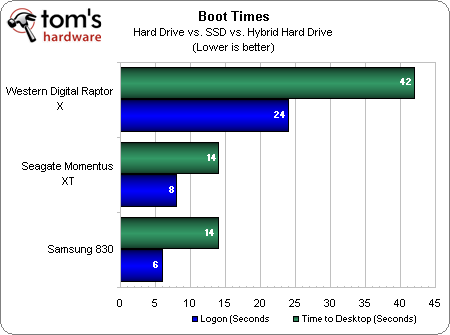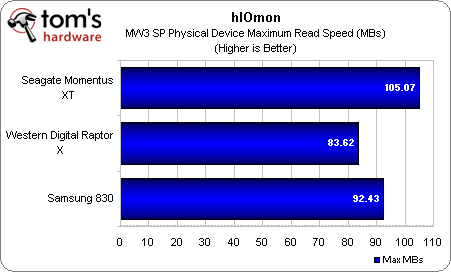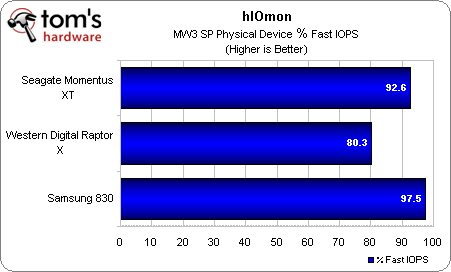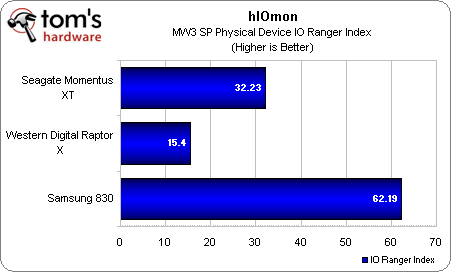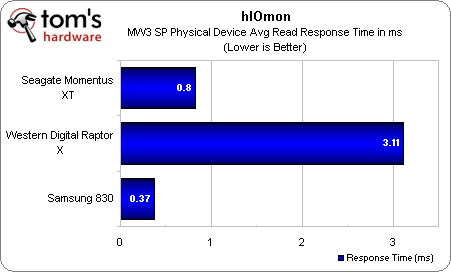In The Lab With Seagate's Momentus XT 750 GB Hybrid HDD
More than two years after reviewing Seagate's first-generation Momentus XT, we're back in the lab with a 750 GB model armed with 8 GB of SLC NAND and a SATA 6Gb/s interface. How does it compare to pure solid-state and hard drive technologies? We dig deep.
Benchmark Results: Boot Time And Game Level Loading
Wishing to translate our measured numbers into actual boot-up times, we recorded the time taken to log on and reach the Windows desktop on each device.
The Momentus XT is only marginally slower than Samsung's 830, and it's significantly faster than Western Digital's Raptor.
As you probably already know, the boot-up process is primarily a random workload involving small block transfers. So, we'll also have a look at game loading. In this exercise, we load Call of Duty: Modern Warfare 3 from the beginning of the game and monitor results at the physical device level. Our Momentus XT results were taken after the game had already been loaded three times during the previous day.
We found that the workload consists of approximately 18% random access reads and 82% sequential access reads, which, by coincidence, is almost the inverse of what we saw during the boot-up process. The average block transfer size increases to 79 KiB and the average queue depth is one.
In addition to monitoring the percentage of fast IOPS and the maximum transfer speed in MB/s, we also record the “Data Transferred/Time Index,” which is a unique metric made available by the hIOmon software. This index provides a high-level means for relative comparison of I/O performance, where "higher is better." That is, a higher index results corresponds to better performance (more data transferred and/or less response time). The hIOmon DXTI metric is calculated by taking the observed amount of data transferred by the I/O operations (converted to megabytes for scaling), and dividing by the combined sum of the observed time durations (actual response times) of the I/O operations responsible for transferring that data.
When you get right down to it, the hIOmon DXTI metric is a lot like a car's fuel economy index insofar as it conveys performance efficiency. It is comparable to more miles driven (more data transferred) for fuel used (response time taken to transfer this data). Or, similarly, the same number of miles driven (data transferred) using less fuel (lower response time).
Quite surprisingly, Seagate's Momentus XT comes out on top in the maximum MB/s transfer speed. But it loses out to Samsung's 830 on the percentage of fast IOPs and the DXTI.
Get Tom's Hardware's best news and in-depth reviews, straight to your inbox.
The Momentus XT does much better than Western Digital's Raptor X when it comes to average read response times, landing closer to the Samsung 830.
Given relatively little time to adapt and learn, Seagate's Momentus XT is able to perform a lot more like an SSD than a hard drive. Boot times are not noticeably longer than you'd see from an SSD, and the Windows desktop is responsive as soon as it loads. Applications do realize that "snappy" SSD feel. There are inevitably occasions when the Momentus XT does feel more like a hard drive because its NAND doesn't contain the information you're requesting. In general, though, the trade-off is tolerable.
Current page: Benchmark Results: Boot Time And Game Level Loading
Prev Page Benchmark Results: Boot-Up In hIOmon Next Page The Value Of SSDs, Hard Drives, And Hybrid Hard Drives, Compared-
sunsmasher So it sounds like the hot setup is SSD for OS/Apps, and HHDD for storage of frequently used media, with a 2TB+ hard drive for storage/archiving of other media.Reply -
americanbrian I don't like your spider graph for reliability.... Does the Hybrid Drive still "work" when either the flash or spinning discs fail?Reply
If not (which it is easy to argue it would at least not be working properly if at all). Then you must say it has twice the chance at failure. This is because if there is a 1:1000 chance of the HD part failing, and a 1:1000 cahnce of the flash failing (your spider shows them to be roughly equal) then there is a 2:1000 chance of "drive" failure in total (or 1:500).
That is called "probability" it is funny like that. Think of it like a weird RAID 0 array. -
hunshiki The idea is great in my opinion, but they could include a 16gb SSD inside the drive. Or 32.Reply -
akamrcrack Would have been nice to see you include SSD caching drives like the Crucial Adrenaline in this study.Reply
My Adrenaline + Samsung Spinpoint F3 1TB 7200rpm HDD say they are the better buys :)
Installed my OS onto my HDD (was originally on a Crucial M4 64GB) then installed the Caching software from Dataplex and watched the sparks fly!
Now my Spinpoint runs as fast as my Intel 320 series 120GB SSD in CrystalDiskMark :)
Plus I can always upgrade to a 2TB HDD meaning I can have 2TB of space running at SSD speeds all day :)
When you are a srs gamer like me and you have hundreds of games to store and no SSD capable of holding them, you begin to want to find solutions to solve that. Well ever since I installed the caching drive + software (very simple) everything about my HDD is fast!
Momentus is old and tried. The only thing I know of that can match the performance of my HDD+SSD cache is a new gen velociraptor 1TB HDD that costs around $320. Which could get me 2TB of storage and the SSD cache and still have money left over lol so neither new gen raptors or momentus are worth the cost unless you are limited to 1x 3.5" bay in your computer.. Even then a 2.5" SSD is very easy to hide in a case..
I've seen the argument "why not just get a regular SSD instead of the Adrenaline, won't they do the same thing?"
My response to that is, for the average user that wants simplicity getting a SSD premade for caching that comes with quality software is the way to go. The Dataplex software is very very light and as simple as install then forget it existed. -
A comparison with Intel's SRT technology (combines up to 64GB SSD with a traditional HD) would have been interesting. I wonder what evidence made Intel choose 64GB and Seagate choose 8GB? What is the optimal amount of SSD to pair with an HD generally speaking?Reply
-
mariusmotea To test a Hybrid drive you need to use it several hours. of course that benchmarks files has been cached into the SSD. Let's see the startul speed after i browse the internet for few hours and play a game for 30 minutes. I don't belive that the statup files will be in ssd anymore.Reply -
dthx Of course a SSD + big 3.5 drive is always a better solution but... impossible to achieve in most portable PC's. This is where the hybrid shines: you don't have to choose between decent performances and sufficient and affordable capacity. I've put such a drive (and Win7 instead of Vista) in a 4 year old XPS-1330 and after a few reboots it has become an extremely capable machine (faster than any brand new laptop with a conventional HDD).Reply -
cscott_it I recall another site (maybe Anandtech?) putting a couple of these in a RAID 0 configuration and the performance scaled rather nicely. Any chance you guys are thinking about doing something like that?Reply
